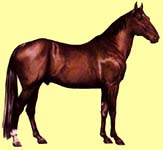|
|
Standardbred |
|
|
|
Standardbred |
|
 In America, harness racing attracts a following of over 30 million people. In many European countries, and in Scandinavia and Russia, it is more popular than
Thoroughbred racing. The supreme harness racer is, without a doubt, the American Standardbred, many of which can go a mile in around 1:55 minutes, and some are even faster.
In America, harness racing attracts a following of over 30 million people. In many European countries, and in Scandinavia and Russia, it is more popular than
Thoroughbred racing. The supreme harness racer is, without a doubt, the American Standardbred, many of which can go a mile in around 1:55 minutes, and some are even faster.
The term Standardbred was first used in 1879, and refers to the early practice of establishing a speed standard as a requisite for entry into the Register. The Standard at that time was set at 2:30 minutes for conventional trotters over 1 mile, and 2:25 for the faster pacers. Today the standard times have been reduced, and the first under 2-minute mile was trotted as early as 1897 by a horse called Star Pointer. Separate harness races are held for conventional trotters (diagonal trotters), and for pacers (lateral gait). The Pacer, faster and less likely to break gait, is preferred in the USA; Europeans prefer trotters.
The Standardbred was founded on Messenger, a Thoroughbred imported from England in 1788. He did not race in harness, but there was a genetic link to Old Shales, founder of the dynasty of Norfolk Trotter in his background, like all early Thoroughbreds. Messenger stood in America for 20 years and died in 1808. He was bred to a variety of mares and with admixtures of Morgan, Narragonsett and Canadian Pacer blood, he was largely responsible for the formation of a breed nucleus.
The foundation sire of the breed is Messenger's descendant, Hambiltonian, foaled in 1849. He, too, never raced in harness, but he had a peculiarity of conformation that contributed to his success as a sire of harness racers. He measured 15.3 1/4 hands high at the croup and 15,1 1/4 hands high at the withers, a structure that gives enormous propulsion to the quarters. Ninety percent of all Standardbreds descend from him and from 1851 to 1875, he sired no less than 1335 offspring.
The body of the Standardbred is longer and lower than the Thoroughbred and without its quality and refinement. The croup in this powerfully built horse is always high; whereas the withers are fairly well defined, but can be lower than the croup. Quarters are exceptionally powerful so as to deliver the maximum possible forward thrust at the trot or pace. The hocks and hind legs have to be very correct in their structure if the horse is to stand up to the demands of racing. Iron-hard legs, very good hooves and the straightest of actions are essential for the Standardbred to race at high speed without risk of injury.
The breed is notable for the strength of the shoulders and their perfect relationship to the neck. Robust is a good description of the muscular, courageous Standardbred and the head can be described in similar fashion, for, in comparison to the Thoroughbred, it is coarse and rather plain, though honest in its outlook. On the average, the Standardbred is 15.2 hands high and its colors are predominantly bay, brown, black, and chestnut.
For more information on Standardbreds, visit:

|
© 1993-2018 >NW Breyer Horse Club & Refiner of Gold Creations Equinealities in place since 1997, Section in place 2001, Updated 2/19/2018 |



|
| ||

|
|||||